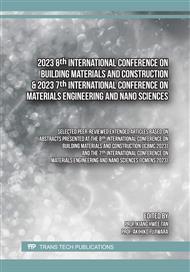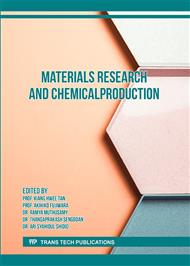[1]
W. Bonfield, M.D. Grynpas, A.E. Tully, J. Bowman and J. Abram, Hydroxyapatite reinforced polyethylene--a mechanically compatible implant material for bone replacement, Biomaterials 2 (1981) 185-186.
DOI: 10.1016/0142-9612(81)90050-8
Google Scholar
[2]
L.M. Fang, Y. Leng and P. Gao, Processing of hydroxyapatite reinforced ultrahigh molecular weight polyethylene for biomedical applications, Biomaterials 26 (2005) 3471-3478.
DOI: 10.1016/j.biomaterials.2004.09.022
Google Scholar
[3]
C. Wu, J. Chang, W. Zhai, S. Ni and J. Wang, Porous akermanite scaffolds for bone tissue engineering: preparation, characterization, and in vitro studies, J. Biomed. Mater. Res. B 78 (2006) 47-55.
DOI: 10.1002/jbm.b.30456
Google Scholar
[4]
P. Monvisade, P. Siriphannon, R. Jermsungnern and S. Rattanabodee, Preparation of hydroxyapatite/poly(methyl methacrylate) and calcium silicate/poly(methyl methacrylate) interpenetrating hybrid composites, J. Mater. Sci. Mater. Med. 18 (2007) 1955-1959.
DOI: 10.1007/s10856-007-3142-2
Google Scholar
[5]
P. Siriphannon, P. Monvisade, S. Jinawath and K. Hemachandra, Preparation and characterization of hydroxyapatite/poly(ethylene glutarate) biomaterials, J. Biomed. Mater. Res. A 81 (2007) 381-391.
DOI: 10.1002/jbm.a.31032
Google Scholar
[6]
Y. Wang, Y. Xiao, X. Huang and M. Lang, Preparation of poly(methyl methacrylate) grafted hydroxyapatite nanoparticles via reverse ATRP, J. Colloid Interface Sci. 360 (2011) 415-421.
DOI: 10.1016/j.jcis.2011.04.093
Google Scholar
[7]
S. Abd-Khorsand, S. Saber-Samandari and S. Saber-Samandari, Development of nanocomposite scaffolds based on TiO2 doped in grafted chitosan/hydroxyapatite by freeze drying method and evaluation of biocompatibility, Int. J. Biol. Macromol. 101 (2017) 51-58.
DOI: 10.1016/j.ijbiomac.2017.03.067
Google Scholar
[8]
C.J. Montaño, T.P.R. Campos, B.R.S. Lemos, M.I. Yoshida, N.G.S. Almeida, M.T.P. Aguilar and C.V. Lima, Effects of hydroxyapatite on PMMA-HAp cement for biomedical applications, Biomed. Mater. Eng. 31 (2020) 191-201.
DOI: 10.3233/bme-206001
Google Scholar
[9]
S. Nath, S. Bodhak and B. Basu, HDPE-Al2O3-HAp composites for biomedical applications: processing and characterizations, J. Biomed. Mater. Res. B 88B (2009) 1-11.
DOI: 10.1002/jbm.b.31050
Google Scholar
[10]
T. Liu, K. Huang, L. Li, Z. Gu, X. Liu, X. Peng and T. Kuang, High performance high-density polyethylene/hydroxyapatite nanocomposites for load-bearing bone substitute: fabrication, in vitro and in vivo biocompatibility evaluation, Compos. Sci. Technol. 175 (2019) 100-110.
DOI: 10.1016/j.compscitech.2019.03.012
Google Scholar
[11]
Y. Zhang and K.E. Tanner, Effect of filler surface morphology on the impact behaviour of hydroxyapatite reinforced high density polyethylene composites, J. Mater. Sci. Mater. Med. 19 (2008) 761-766.
DOI: 10.1007/s10856-007-3119-1
Google Scholar
[12]
K. Okada, M. Tanuma, Y. Kameshima, A. Nakajima, S. Asai and M. Sumita, Bioactivity and Mechanical Properties of CaSiO3/High-density Polyethylene (HDPE) Composites Prepared by A New Surface Loading Method of CaSiO3 Powder, Mater. Res. Bull. 44 (2009) 298-305.
DOI: 10.1016/j.materresbull.2008.06.011
Google Scholar
[13]
K. Lin, W. Zhai, S. Ni, J. Chang, Y. Zeng and W. Qian, Study of the mechanical property and in vitro biocompatibility of CaSiO3 ceramics, Ceram. Int. 31 (2005) 323-326.
DOI: 10.1016/j.ceramint.2004.05.023
Google Scholar
[14]
P. Siriphannon, Y. Kameshima, A. Yasumori, K. Okada and S. Hayashi, Influence of preparation conditions on the microstructure and bioactivity of α-CaSiO3 ceramics: Formation of hydroxyapatite in simulated body fluid, J. Biomed. Mater. Res. Vol. 52 (2000), pp.30-39.
DOI: 10.1002/1097-4636(200010)52:1<30::aid-jbm5>3.0.co;2-z
Google Scholar
[15]
A. Sathain, P. Monvisade and P. Siriphannon, Bioactive alginate/carrageenan/calcium silicate porous scaffolds for bone tissue engineering, Mater. Today Commun. 26 (2021) 102165.
DOI: 10.1016/j.mtcomm.2021.102165
Google Scholar
[16]
T.Kokubo and H. Takadama, How useful is SBF in predicting in vivo bone bioactivity?, Biomaterials 27 (2006) 2907-2915.
DOI: 10.1016/j.biomaterials.2006.01.017
Google Scholar
[17]
S. Rukchonlatee, N. Jaisomboon and T. Sooknoi, Improvement of Water Vapor Permeability of LLDPE/EVA Film with Zeolite A as Filler, Key Eng. Mater. 730 (2017) 31-36.
DOI: 10.4028/www.scientific.net/kem.730.31
Google Scholar
[18]
S.-Y. Fu, X.-Q. Feng, B. Lauke and Y.-W. Mai, Effects of particle size, particle/matrix interface adhesion and particle loading on mechanical properties of particulate–polymer composites, Compos. B. Eng. 39 (2008) 933-961.
DOI: 10.1016/j.compositesb.2008.01.002
Google Scholar
[19]
E.F. Morgan and T.M. Keaveny, Dependence of yield strain of human trabecular bone on anatomic site, J. Biomech. 34 (2001) 569-577.
DOI: 10.1016/s0021-9290(01)00011-2
Google Scholar



